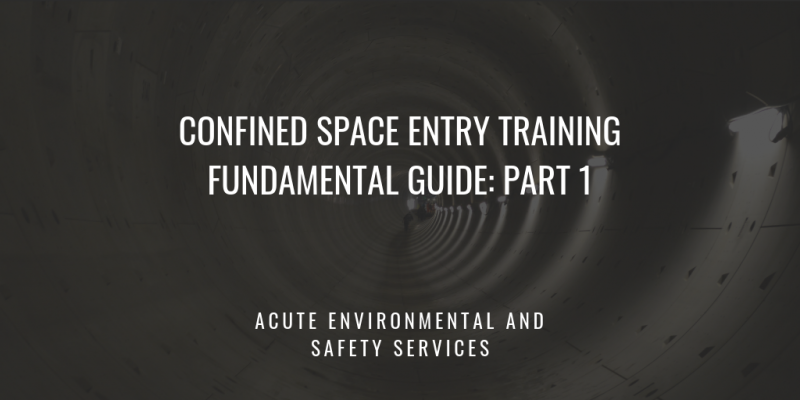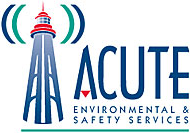
Confined space entry training is essential for everyone whose job requires suiting up and climbing into these potentially hazardous areas. In Part 1 of our Fundamental Guide to Confined Space Entry Training, you will learn about relevant rules and regulations that are in place to ensure maximum security in the workplace. Trust the experienced professionals at Acute Safety and Safety Services to get you trained and keep you safe on the job – contact us or sign up for our confined space entry training today.
Confined Space Entry Training – Fundamental Guide: Part 1
Have you been told you need to take a confined space entry training course but aren’t sure why? In Part 1 of our series, you will learn about the relevant rules and regulations that have been established to keep you safe on the job.
What You Need To Know About Reg. 632/05
Everything you need to know about confined spaces in Ontario comes from Ontario Regulation 632/05, which you can download here.
If you’re not sure what is meant by “confined space” to begin with, it is defined as a fully or partially enclosed space,
(a) that is not both designed and constructed for continuous human occupancy, and
(b) in which atmospheric hazards may occur because of its construction, location, contents, or because of work that is done in it.
Examples of spaces that are not designed and constructed for continuous human occupancy include tanks, vessels, silos, storage bins, hoppers, vaults, pits, manholes, tunnels, equipment housings, ductwork, and pipelines.
“Atmospheric hazards” include the following:
- The accumulation of flammable, combustible, or explosive agents,
- An oxygen content in the atmosphere that is less than 19.5% or more than 23% by volume,
- The accumulation of atmospheric contaminants, including gases, vapours, fumes, dusts, or mists that could result in acute health effects that pose an immediate threat to life or interfere with a person’s ability to escape unaided from a confined space.
If your workplace has a space that is fully or partially enclosed, the two conditions above must both apply before the space can be defined as “confined.”

Everything you need to know about confined spaces in Ontario comes from Ontario Regulation 632/05
How You Determine If a Space is Confined
To determine whether a “space” meets the definition of a confined space, you should ask the following three questions:
- Is the space fully or partially enclosed?
- Is the space not both designed and constructed for continuous human occupancy?
- Might an atmospheric hazard occur?
The only way to determine if a specific area meets the definition of a confined space is to evaluate it, and how the evaluation is done is up to the employer.

You need to know how to determine whether a space is “confined” by definition
How You Are Kept Safe in Confined Spaces
In section seven of Reg. 632/05, you can see that “Before any worker enters a confined space, the employer shall ensure that an adequate written plan, including procedures for the control of hazards identified in the assessment, has been developed and implemented by a competent person for the confined space.”
The plan can be incorporated into the necessary entry permit and must contain provisions for the following:
- the duties of workers
- on-site rescue procedures
- rescue equipment and methods of communication
- personal protective equipment, clothing, and devices
- adequate means for entering and exiting
- atmospheric testing
- adequate procedures for working in the presence of explosive or flammable substances
- ventilation and purging
All of this is contingent on you being certified, and you will learn about who needs confined space entry training in Part 2 of this series.

Your employer is mandated to have a plan in place before you enter a confined space
Get Confined Spaces Training With ACUTE!
Acute Environmental – Confined Space from Acute Safety on Vimeo.
Hands-on, practical confined space entry training is the best way to keep employers and workers safe in the workplace!
ACUTE is dedicated to workplace safety and understands the importance of course and training provider approval. ACUTE offers many training courses to help workers, employers, and everyone else involved stay safe on the job.
You can trust ACUTE to help your business understand your training challenges while also taking care of the most crucial aspect of a safety program: providing unparalleled tailoring and customer service. Contact us today.
“We have used Acute Environmental & Safety Services Inc. for many years and our personnel always come back well trained, energized and bringing lots of ideas. They are provided with substantial and in-depth knowledge together with challenging opportunities to put into practice what they have learned into our field operations.” – Dante, Environmental Service Company.
ACUTE is located in Waterloo, Ontario, and services customers from cities such as Toronto, Mississauga, Brampton, Hamilton, Milton, Kitchener, London, Guelph, and others across Ontario.


